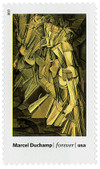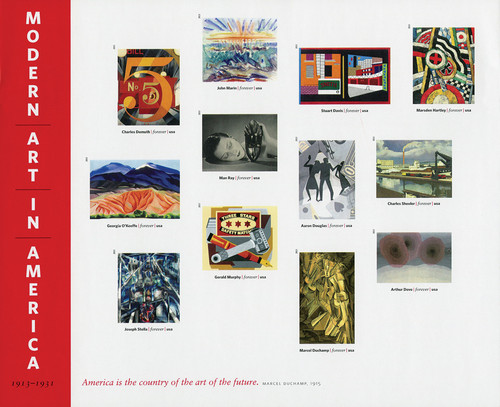
2013 First-Class Forever Stamp,Modern Art in America: Marcel Duchamp's "Nude Descending a Staircase, No. 2"
# 4748k - 2013 First-Class Forever Stamp - Modern Art in America: Marcel Duchamp's "Nude Descending a Staircase, No. 2"
$2.25 - $3.75
U.S. #4748k
2013 46¢ Marcel Duchamp
Modern Art in America
Issue Date: March 7, 2013
Quantity: 1,950,000
Perforations: Serpentine Die Cut 10 1/2
Color: multicolored
Perforations: Serpentine Die Cut 10 1/2
Color: multicolored
Marcel Duchamp’s painting Nude Descending a Staircase, No. 2 is one of twelve featured on the Modern Art in America: 1913-1931 stamps.
Described as “a one-man movement,” Marcel Duchamp challenged the conventions of his day, creating a new art form known as “readymades.”
Born in France, Duchamp (1887-1968) first gained attention in 1912 with his painting, Nude Descending a Staircase, No. 2. The painting was Cubist and Futurist-inspired, as it pictures a body in continual motion. But it was immediately rejected by his peers and he was asked to remove it from the gallery where it was to be displayed. The following year, he exhibited it at the Armory Show in New York City, where it sparked wide-spread controversy and interest.
Over time, Duchamp came to reject the art of his peers, which he felt was created only to please the eye. He thought art should engage the mind. It was at this time that he conceived the “readymade.” Readymades are common items, sometimes altered, arranged, and placed on display. Duchamp believed if he called it art, that made it art. True to his personality, these works were often satirical, ironic, or humorous and pushed the limits of both public taste and artistic technique.
His most famous readymade, Fountain, was simply a urinal, signed “R. Mutt.” His display of the piece in 1917 caused controversy once again, as he became a figure of the growing movement against conventional understanding of the nature and status of art.
U.S. #4748k
2013 46¢ Marcel Duchamp
Modern Art in America
Issue Date: March 7, 2013
Quantity: 1,950,000
Perforations: Serpentine Die Cut 10 1/2
Color: multicolored
Perforations: Serpentine Die Cut 10 1/2
Color: multicolored
Marcel Duchamp’s painting Nude Descending a Staircase, No. 2 is one of twelve featured on the Modern Art in America: 1913-1931 stamps.
Described as “a one-man movement,” Marcel Duchamp challenged the conventions of his day, creating a new art form known as “readymades.”
Born in France, Duchamp (1887-1968) first gained attention in 1912 with his painting, Nude Descending a Staircase, No. 2. The painting was Cubist and Futurist-inspired, as it pictures a body in continual motion. But it was immediately rejected by his peers and he was asked to remove it from the gallery where it was to be displayed. The following year, he exhibited it at the Armory Show in New York City, where it sparked wide-spread controversy and interest.
Over time, Duchamp came to reject the art of his peers, which he felt was created only to please the eye. He thought art should engage the mind. It was at this time that he conceived the “readymade.” Readymades are common items, sometimes altered, arranged, and placed on display. Duchamp believed if he called it art, that made it art. True to his personality, these works were often satirical, ironic, or humorous and pushed the limits of both public taste and artistic technique.
His most famous readymade, Fountain, was simply a urinal, signed “R. Mutt.” His display of the piece in 1917 caused controversy once again, as he became a figure of the growing movement against conventional understanding of the nature and status of art.










